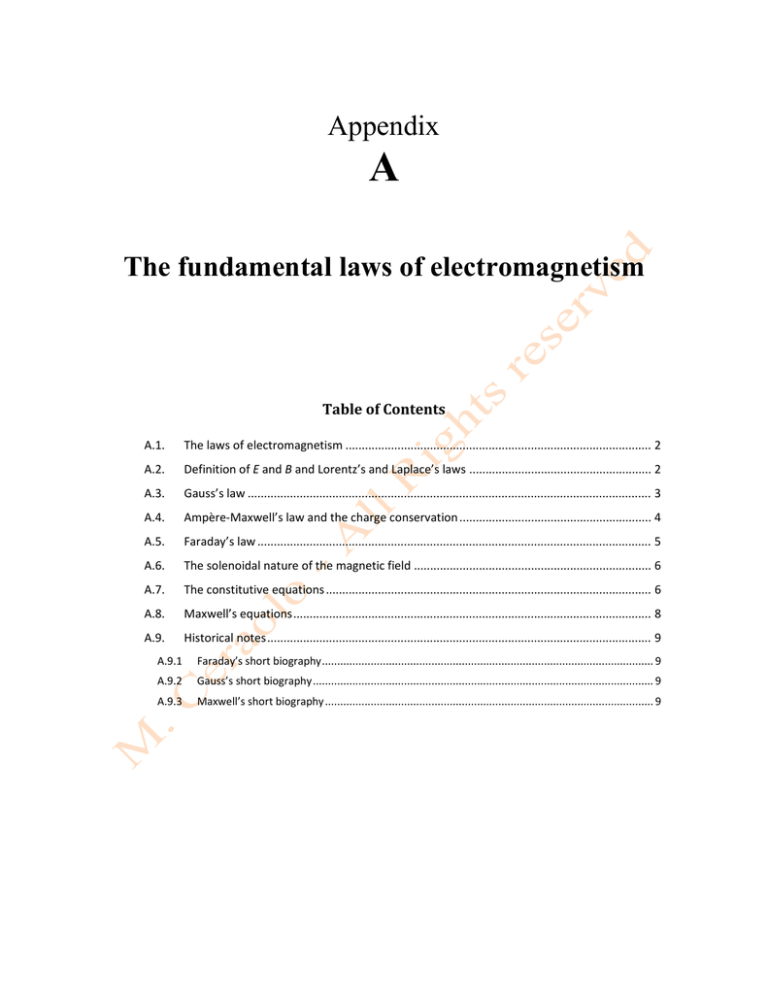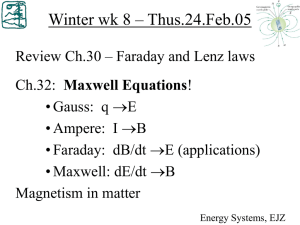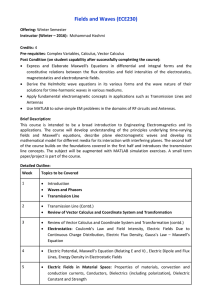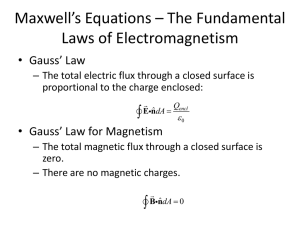Appendix The fundamental laws of electromagnetism
advertisement

Appendix A The fundamental laws of electromagnetism Table of Contents A.1. The laws of electromagnetism .............................................................................................. 2 A.2. Definition of E and B and Lorentz’s and Laplace’s laws ........................................................ 2 A.3. Gauss’s law ............................................................................................................................ 3 A.4. Ampère‐Maxwell’s law and the charge conservation ........................................................... 4 A.5. Faraday’s law ......................................................................................................................... 5 A.6. The solenoidal nature of the magnetic field ......................................................................... 6 A.7. The constitutive equations .................................................................................................... 6 A.8. Maxwell’s equations .............................................................................................................. 8 A.9. Historical notes ...................................................................................................................... 9 A.9.1 Faraday’s short biography ............................................................................................................. 9 A.9.2 Gauss’s short biography ................................................................................................................ 9 A.9.3 Maxwell’s short biography ............................................................................................................ 9 A.2 Appendix A: The fundamental laws of electromagnetism A.1. The laws of electromagnetism The reader of this book is supposed to have a good knowledge of the basic laws of electromagnetism: Gauss’, Ampere’s (with Maxwell’s addition of displacement current), and Faraday’s laws, the solenoidal nature of the magnetic field, the definitions of E and B by means of the induced forces. Moreover, electromagnetic analysis requires knowledge on how matter reacts to electromagnetic fields, i.e. the matter constitutive equations. In this book, all these laws are recalled whenever they are required to introduce new topics. In this Appendix, they laws are summarised, to give the reader a place where to find all of them together, and with the symbology used throughout the book, that may somewhat differ from the one used in previous courses. The user can be confidently stick with the symbology used here, and try to absorb it also for use in their future life, since it is strictly compliant with the international standards, in particular with the standard IEC 60027. It is obviously impossible for anyone to teach or understand electromagnetics in a few pages; therefore this appendix’s purpose is just to recall concepts the reader should already know, at least at a basic level. It is therefore written at two levels, the higher for those that know electromagnetics because they have attended a university-grade course, the lower for those that just have some secondary school’s knowledge of it. The latter is visually indicated by boxes named “link to basic electromagnetics” It starts from the definitions of electric and magnetic fields, that create a link between the worlds of mechanic and electromagnetic phenomena. Remember that all the symbols used here are the symbols recommended by International Standards and summarised in section 1.2.4 of chapter one. A.2. Definition of E and B and Lorentz’s and Laplace’s laws Today the electromagnetic laws are expressed in terms of two fields: the electric field strength E and the magnetic flux density B. They are force fields per unit charge. Their definition is therefore issued by means of the force they create onto a charge in a given point of space (eqs. A.1 and A.2.) If a force F1 is exerted on a stationary charge q located in a point of space, by definition the electric field E in that point is the force per unit charge: F1 qE (A.1) If a charge q is moving velocity v in a point where no electric field exists the magnetic flux density B in that point is the force a vector linked to that force and speed with the relation: F2 q v B (A.2) The force at the left side of eq. (A.2) is normally referred to as Lorentz’s force. Combining A.1 and A.2 the total force acting on a charge q is given by: F F1 F2 q( E v B) (A.3) M. Ceraolo - D. Poli: Fundamentals of Electrical Engineering A.3 Definition: electric field strength The electric field strength in a point of space is the force per unit charge that acts on a stationary charge that is located in that point of space. Definition: magnetic flux density The magnetic flux density in a point of space is a vector that creates a force exerted on a moving charge, in that point of space where no electric field exist, according to the relation: F2 q v B . By means of simple modifications of eq. (A.2) the following equation is easily found: (A.4) dF I dl B I B dl where dl =Idl is a infinitesimal length of the conductor carrying current I, directed as I. The equivalence of (A.2) and (A.4) is easily shown. If an infinitesimal charge moves at a speed v, in a magnetic field density B, Lorentz’s force on it is: : dF dq v B But this charge will move in a conductor along its length l, and in a time interval dt will cover the distance dl. Thus dl dF dq v B dq B Idl B dt Eq. (A.4) is normally referred to as Laplace’s equation of electromagnetically induced force. Link to basic electromagnetics The forces produced on charge flows by the presence of a magnetic flux density field B are expressed in a simple way when the speed v or the direction of the conductor in which the current l flows are orthogonal to B: F q v B F I l B ( when v B) (A5) To find the direction of the force vector we can use the right-hand rule: we consider, in the order given, the directions of second and third factors of (A.5). If they are oriented as index, and medium of a right hand, then the corresponding forces are oriented as the thumb of the same hand. The technique can be applied instead of considering, paying attention to their sequence, index, medium and thumb fingers, considering medium thumb and index, or thumb index and medium. A.3. Gauss’s law To express Gauss’s law, is useful to first define the vector D as the electrical flux density that is proportional to the electric field and the proportionality constant is a constant characteristic of the matter existing in the point where D and E are evaluated, called electrical permittivity: D E The flux across a surface A of the electrical flux density is called electric flux : D dA A Gauss’s law can be stated a follows: “the electrical through a closed surface A(v) surrounding volume v of space containing the electric charge Q equals Q”, i.e.: A.4 Appendix A: The fundamental laws of electromagnetism D dA A(v ) E dA dv Q A( v ) (A.6) v Link to basic electromagnetics In basic electromagnetics it is easier to start consideration of the Gauss’s law from the Coulomb’s law, that indicates the value of the electric field produced at a distance r by the presence of a charge Q (occupying a region of space very small with respect to r): Q E r1 4r 2 where - r1 is a unit length vector from the centre of the space occupied by Q and the position where E is computed. - is the permittivity of the medium in the position where E is computed. In case of a point charge Q, E is directed as a ray starting from the point where Q resides and directed towards the point where E is measured. We call , flux of E, the product of E times the spherical surface. It is apparent that: Ψ Q/ that is Gauss’s theorem (in its basic form). A.4. Ampère-Maxwell’s law and the charge conservation To express Ampère’s law, is useful to first define the vector H as the magnetic field that is proportional to magnetic flux density according to the relation: B H in which , called magnetic permeability, is a constant characteristic of the matter existing in the point of space in which H and B are evaluated. Ampère’s law can be stated a follows: “the line integral of the magnetic flux density B over a closed path l equals the current density flux across any surface bounded by l A(l): H dl J dA A( l ) l J dA dA dl di=JdAcos The current density J is due to moving charges in a conductor means (metal, electrolytic solution), so that di J dA is the current flowing into the infinitesimal surface dA, as indicated in the sketch aside. Ampère’s law was modified by Maxwell. Maxwell added a new term to current density, creating the total current density that is therefore considered to be the sum of conduction and displacement current densities: D Jt J t where D / t is by definition the displacement current density. Ampère-Maxwell’s law is therefore: H dl l A( l ) J t dA D J dA t A( l ) (A.7) M. Ceraolo - D. Poli: Fundamentals of Electrical Engineering A.5 Remember that for the equation to be correct also in sign, the curve l must be traversed in a direction that is seen as counterclockwise from an observer having his eye on the side of A where the arrow of vector A resides. As well known, Maxwell’s addition to Ampère’s law has tremendous impact on electromagnetics, and allows to explain and mathematically describe the generation and propagation of electromagnetical waves. Link to basic electromagnetics Ampère’s law can be expressed in very easy terms in the particularly important case of an indefinite, straight conductive wire in which the current I flows. If r is the distance between the point where H is computed and the wire in which I flows, it can be stated that: I H 2r where the direction of H is along the circumference lying in the plane orthogonal to the wire direction containing the point where H is evaluated. The following important consequence of the Ampère-Maxwell law can be obtained mixing (A.6) and with (A.7): Q J dA (A.8) t A( v ) i.e. the charge conservation law, that states that “the charge exiting any fixed volume v bounded by surface A of space through current density J equals the variation of the charge present accumulated inside v” or, even more effectively for its consequence in circuit theory: J t dA (A.9) A(v) i.e. “the total charge exiting a fixed volume v bounded by surface A is always null,” where obviously the total charge flow is the flow of the above-defined total current density. dA1 A1 dl To prove (A.8) consider a volume v bounded by surface A, as in the sketch aside. If the surface is crossed by an arbitrary plane , the curve l is determined, and A is decomposed in its constituting parts A1 and A2. (A.7) says that: H dl J t dA1 J t dA2 A1 (l ) l A2 dA2 therefore A2 (l ) J t dA 0 whatever the volume v bounded by surface A A (A=A1+A2) A.5. Faraday’s law Faraday’s law can be stated as follows: “the line integral of the electric field strength E over a closed path l equals the flux of the magnetic flux density time derivative across any surface A(l) bounded by l: B (A.10) E dl t dA l A(l ) The minus sign reported in eq. (A.10) is a consequence of the definition assumed for E, B. A.6 Appendix A: The fundamental laws of electromagnetism Obviously enough, changing a sign in the definition of E or B would switch that sign into a plus. However this is not advisable, since the signs assumed here are the same used all over the world and even enclosed in International standards. Link to basic electromagnetics Faraday’s law can be expressed in very easy terms considering a loop wire. If l is the wire path and A(l) is a surface bounded by l, the Faradays’ law states that: d Ef dt where is the magnetic flux crossing A(l), Ef is the electromotive force induced by the variation of , and the signs are chosen in such a way that using he right hand rule for determining the positive current flow sign in the loop associated with , Ef is positive when the current flow with the sign so determined is exiting from its positive polarity. The expression “electromotive force” is often abbreviated to e.m.f. or EMF. A.6. The solenoidal nature of the magnetic field A very important law of magnetism is constituted by the solenoidal nature of the magnetic field, although this law is not traditionally attributed to a specific scientist, and therefore does not carry a specific name. This law is states that the flux of vector B through whatever closed surface A is always 0. B dA 0 (A.11) A Link to basic electromagnetics The solenoidal nature of the magnetic flux density implies that no magnetic charge exists, and therefore the force lines of B and H=B/ are always constituted by closed loops. A.7. The constitutive equations The laws of electromagnetics are fundamental laws that apply to any system, independently of how it is constituted. The constitution of matter in which the electromagnetic phenomena insist, however, plays a very important role on the behaviour of the above quantities. Neglecting the possibility of anisotropic behaviour, i.e., behaviour of matter that depends on the direction of fields applied to it, that is well beyond the scope of this book, the constitutive equations of the matter are the following ones: D E B H J E where , , and are constants in general depending on the point of space considered, and are called permittivity, permeability and conductibility respectively. These constants have been already used when describing the electromagnetics laws in basic terms in the above sections, since within basic electromagnetics, by tradition, rigorous distinction between laws and constitutive equations is not made. The third of these constitutive equations, i.e. E J or E J (where =1/ is the resistivity of the considered substance) is often called pointwise Ohm’s law. M. Ceraolo - D. Poli: Fundamentals of Electrical Engineering A.7 Because of its importance, pointwise Ohm’s law requires some further explanation, having a inner look at a current-carrying conductor. The classic electromagnetics theory assumes that conductors have inside some electrons, as charges able to freely move in the conductor. Indeed these charges move very rapidly as a consequence of the thermal agitation, with speeds in the order of 106 m/s. This movement, however, causes a lot of collisions with the conductor lattice to occur. When an external electric field, i.e. a force per unit charge is applied, the charges are accelerated in such a way that a drift speed, in the order of 10-4 m/s is superimposed to the thermal speed. This drift speed of charges is macroscopically seen as a current (charge per unit of time) flow. This justifies that an electric field causes some current to flow, and that the higher the electric field, the larger the charge flow, and therefore the current. To understand why the field-current density correspondence is proportional, see the small text below. The force applied to the charges induces acceleration to them, so the resulting speed, in absence of collisions, would increase indefinitely; the effect of collisions is however similar of some damping to the charging movement; therefore applying an external force to a charge cloud causes the speed to raise up to a regime value determined by the equilibrium between force applied and force due to damping, in turn due to collisions. It can be demonstrated, however that this regime speed is reached in times that are very small with respect to the application of the external electrical field, in the order of 10-14s, a such tiny time that can be neglected in all the applications considered in electrical engineering and therefore it results possible to state pointwise Ohm’s law, in which the electric field is assumed to be to be proportional to the electric current density, i.e. the force applied to the charges is proportional to the charge (regime) drift speed. The thing can be mathematically seen considering only the effects of electric field E, and therefore force F1 of (A.1). Using this simplification, electric charge speed can be find as the solution of the following equation: dv m (°) m v eE dt where m and e are the electron mass and charge respectively, E is the electric field, and , the time constant of the equation, can be computed from known physical parameters and occurs to be for copper, as already quoted, around 10-14s. Given equation (°), if an external field E is applied to a charge q, it will first be accelerated, but will soon (35 times the value of ) reach the regime velocity vreg=eE/m. The value of is so small that in nearly all the circuits and systems studied by electrical engineers the transient in which v varies can be neglected and electrons be taken as having all the same the regime velocity: v m eE Drift speed and current are connected to each other. Consider the drawing aside, showing a piece of conducting material carrying current inside. In the infinitesimal time interval dt the charges flow in the conductor at the drift speed v=dx/dt. the charge contained in the volume of conductor long dx at the end of dt will have flown through the cross section of the x x+dx conductor. The charge flow can be correlated to the charges existing in the conductor. If n indicates the number of electrons per unit volume and e the electric charge of an electron it will be: dQ nedxS Idt and dx vdt eE dt m Consequently: I ne eE dt S Idt J ne2 E or J E with ne 2 m S m m dx The latter equation allows, using reasonable values for n, e, m, , to evaluate giving again a value of about 10-14s. A final point on pointwise Ohm’s law is that it relates the total force field acting on the charge within conductors, in the direction of charge flow, not only that produced by electric charges present in the space near the considered point. In cases when more than a force field is present, it writes: A.8 Appendix A: The fundamental laws of electromagnetism E t J where Et is the total force field acting on the charges, per unit of charge. For instance, in chapter 3, when a microscopic view at circuits is made to justify the utilisation of the abstract circuit concept to physical DC circuits, the following is used: Et Ec E s where Ec was due to chemical reactions, while Es was due to electric charges. A.8. Maxwell’s equations It is well known that Maxwell in addition to have given a fundamental contribution to D to the current density vector J to obtain the total current Ampère’s law, adding the term t density J t (cf. A.4), has also performed a systematic classification of the basic laws of electromagnetism. He has summarised everything in four basic laws, that can be expressed in integral or differential form. Maxwell’s equations in integral form have already been introduced earlier in this appendix, and are summarised here for clarity. They are compared with the corresponding basic forms that are typically taught in basic electromagnetics courses. Note that the basic forms are mathematically equivalent to Maxwell’s integral forms, except for Faraday’s that, as already mentioned, was actually modified by Maxwell. Consider that these equations are reported with the classical names of the laws that were used and named before Maxwell’s systematisation, and not as “first”, “second”, etc. Maxwell’s laws. This eases immediate correspondence in the reader’s mind of the Maxwell’s and basic forms of these equations. Maxwell’s equations in their differential form are used in specialists environments, and are therefore beyond the scope of this book. They have been reported in the table B.I only for completeness, but they are not discussed at all. Table B.I: Summary of electromagnetism laws in different forms (differential forms, reported only for completeness, are out of this book’s scope). Law Faraday’s Gauss’s Basic form Ef d dt Maxwell’s integral form l D dA dv Q E dA Q / A(v ) B dA t A(l ) E dl A( v ) I 2r Ampère’s H AmpèreMaxwell’s - solenoidality of B “magnetic lines always form closed loops” Maxwell’s differential form B E dt D v - - H dl l A( l ) B dA 0 A J t dA A( l ) (J D ) dA t H J B 0 D t M. Ceraolo - D. Poli: Fundamentals of Electrical Engineering A.9 A.9. Historical notes A.9.1 Faraday’s short biography Michael Faraday1 (London, England 1791 - London, England 1867) has been a chemist and physicist that is considered one of the best experimentalists who ever lived. He first studied as an autodidact chemistry, working in particular on electrochemistry, and issuing the fundamental laws of electrolysis. Later he worked successfully also on electromagnetism. His main achievements are the quantitative evaluation of the electric charge per mole of electrons, today called Faraday’s constant, and the mathematical expression of induction law, today called Faraday’s law. this law is so important in the Electrical Engineer activity that will be quoted many times throughout this book. He made also important contributions in other fields of physics. His importance in electromagnetism is sealed by the adoption in the SI of the farad (symbol: F) for the unit of measure of capacitance of capacitors. A.9.2 Gauss’s short biography Johann Carl Friedrich Gauss2 (Braunschweig, Germany 1777 - Hannover, Germany, 1855) is considered to be one of the greatest mathematicians of the whole history. He was also been an excellent physicist and astronomer. His contribution as mathematician was in many fields such as the demonstration of the fundamental theorem of algebra, the complex number graphical representation, the distribution of statistical errors (today called gaussian curve), theorems related to the curvature of surfaces. He also first hypothesized the existence of non-euclidean geometries. His contribution to electromagnetics, was also very important. Fundamental is the theorem that he demonstrated and is today called Gauss’s flux theorem A.9.3 Maxwell’s short biography James Clerk Maxwell (Edimburg, UK, 1831 - Cambridge UK, 1879) He was one of the greatest physicist of all times, whose work is often compared to Newton’s and Einstein’s. His most important contributions are in the file of gas kinetic theory, and of electromagnetism. In the latter topic he provided a highly effective unification of all the electromagnetism laws: the whole electromagnetics phenomena were then summarised in his four famous equations. From these equations, he demonstrated the existence of electromagnetic waves and that electricity, magnetism and even light are all manifestations of the same phenomenon, the electromagnetic field. His analysis includes the introduction of a new term in Ampère’s law (the term D / t in (A.7)), with the concept of displacement current, that only allows his theory to develop and the electromagnetic wave to be demonstrated. At the time of his death, Maxwell’s theory of electromagnetism was one of several. Its correctness was established only in 1887, when it was experimentally verified by Hertz. 1 2 Pronounce (from Oxford English Dictionary): /’færədeɪ/ Pronounce (from Oxford English Dictionary): /gaʊs/





